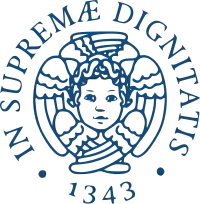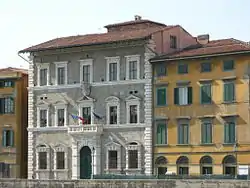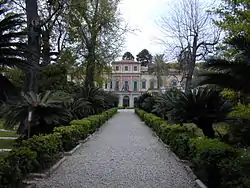University of Pisa
The University of Pisa (Italian: Università di Pisa, UniPi) is an Italian public research university located in Pisa, Italy. It was founded in 1343[1] by an edict of Pope Clement VI. It is the 19th oldest extant university in the world and the 10th oldest in Italy.[2] The university is ranked within the top 10 nationally and the top 400 in the world according to the ARWU and the QS. It houses the Orto botanico di Pisa, Europe's oldest academic botanical garden, which was founded in 1544.
Università di Pisa | |
 Seal of the University of Pisa | |
| Latin: Universitas Pisana | |
| Motto | In supremae dignitatis |
|---|---|
Motto in English | In supreme dignity |
| Type | Public |
| Established | 1343[1] |
| Rector | Paolo Mancarella |
Administrative staff | 1,900 |
| Students | 46,000 |
| 3,500 | |
| Location | , |
| Campus | Urban/University town |
| Sports teams | US Pisa |
| Affiliations | ICoN, EUA, URA, PEGASUS |
| Website | www |
The University of Pisa is part of the Pisa University System, which includes the Scuola Normale Superiore and the Sant'Anna School of Advanced Studies. The university has about 50,000 students (of which 46,000 are undergraduate and postgraduate studies, and 3,500 are doctoral and specialization studies).
In the fields of philology and cultural studies, the University of Pisa is a leading member of ICoN, an inter-university consortium of 21 Italian universities supported by the Ministry of Education, Universities and Research, as well as a member of the European University Association, the Partnership of a European Group of Aeronautics and Space Universities network and the Cineca consortium. It's the only university in Italy which has become a member of the Universities Research Association.[3]
Among its notable graduates there are several national and foreign political leaders including two Italian presidents, five Popes, five Italian prime ministers and three Nobel Laureates as students, faculty or staff affiliates.
Pisa has an intense athletic rivalry with the University of Pavia, which traditionally culminates in the Pisa-Pavia Regatta (Regata Pisa-Pavia), the oldest competition of this kind in Italy, and second in Europe only to the Oxford Cambridge boat race.
In 2013, the University of Pisa finished with La Sapienza University of Rome in first place among the Italian universities, according to the Academic Ranking of World Universities.[4][5][6]
History


The University of Pisa was officially established on 3 September 1343.[1] However, a number of scholars claim its origin dates back to the 11th century.
The first reliable data on the presence of secular and monastic schools of law in Pisa is from the 11th century and the second half of the 12th century, a time when Pisa had already achieved a remarkable economic development. The following century formed the first documents to prove the presence of doctors of medicine and surgery.
The earliest evidence of a Pisan Studium dates to 1338, when jurist Ranieri Arsendi transferred to Pisa from Bologna. He, along with Bartolo da Sassoferrato, a lecturer in civil law, were paid by the municipality to teach public lessons.
The papal bull In supremae dignitatis, granted by Pope Clement VI on 3 September 1343, recognized the Studium of Pisa as a Studium Generale; an institution of further education founded or confirmed by a universal authority, the Papacy, or Empire. Pisa was one of the first European universities to boast this papal attestation, which guaranteed the universal and legal value of its educational qualifications.
The first taught subjects were theology, civil law, canon law and medicine. In 1355, Francesco da Buti, the well-known commentator of Dante's Divine Comedy, began teaching at the Studium.
Pisa and its Studium underwent a period of crisis around the turn of the 15th century: the Florentines' conquest of the town led to the university's closure in 1403. In 1473, thanks to Lorenzo de Medici, the Pisan Studium resumed its systematic development, and the construction of a building for holding lessons was provided for in 1486. The building — later known as Palazzo della Sapienza (the "Building of Knowledge") — was located in the 14th-century Piazza del Grano. The image of a cherub was placed above the gate Dell'Abbondanza (the "Gate of Abundance"), leading to the piazza, and today is still the symbol of the university.
Following the rebellion and the war against Florence in 1494, the Pisan Studium suffered a period of decline and was transferred to Pistoia, Prato and Florence. The ceremonial reopening of the university on 1 November 1543, under the rule of Duke Cosimo I de Medici, was considered as a second inauguration. The quality of the university was furthered by the statute of 1545 and the Pisan Athenaeum became one of the most significant in Europe for teaching and research. The chair of Semplici (botany) was held by Luca Ghini, founder of the world's first botanical gardens. He was succeeded by Andrea Cesalpino, who pioneered the first scientific methodology for the classification of plants, and is considered a forerunner in the discovery of blood circulation. Gabriele Falloppio and Marcello Malpighi lectured in anatomy and medicine. Galileo Galilei, who was born and studied in Pisa, became professor of mathematics at the Pisan Studium in 1589.
The university's role as a state institution became more accentuated during the Medici Grand Duchy period. A protectionist policy ensured a consistent nucleus of scholars and teachers. Laws issued by Cosimo I, Ferdinando I and Ferdinando II obliged those who intended to obtain a degree to attend the Studium of Pisa. Many notable figures lectured at Pisa, especially in the fields of law and medicine.
The university's development continued under the Lorenas. They completed the construction of the astronomic observatory (a project initiated by the Medicis), and enriched the university library with important publications. They helped develop the botanical gardens, and natural science museum, and established new chairs including experimental Physics and Chemistry.
The annexation of Tuscany to the Napoleonic Empire resulted in the transformation of the Studium into an Imperial Academy. The Athenaeum became a branch of the University of Paris, and the courses and study programs were structured following the French public education model. Five new faculties were established: (theology, law, medicine, science and literature), along with examinations, different qualification titles and graduation theses. In 1810 the scuola normale was established, after the École normale of Paris.
The Restoration wasn't able to cancel the effects of the Napoleonic experience. The first Congress of Italian Scientists was held in Pisa in 1839. Over 300 experts of various disciplines and 421 scientists discussed zoology, comparative anatomy, chemistry, physics, mathematics, agronomy, technology, botany, vegetation physiology, geology, mineralogy, geography and medicine.
In 1839–1840, the Director of Education Gaetano Giorgini brought about the most important reform in the University of Pisa by raising the number of faculties to six (theology, law, literature, medicine, mathematics, and natural sciences). Giorgini also created the world's first chair of agriculture and sheep farming.
In 1846, the Scuola Normale reopened. At the same time, liberal and patriotic ideals were spreading at Athenaeum and a battalion of the university (composed of lecturers and students) distinguished itself in the Battle of Curtatone and Montanara in 1848.
During the Second Restoration in 1851, Leopoldo II united the universities of Pisa and Siena in a unique Etruscan Athenaeum, motivated in part by economic reasons, but primarily for political control. The faculties of theology and law rested at Siena, while those of literature, medicine, mathematics and natural sciences remained at Pisa. Following the Florentine insurrection and the fleeing of the Grand Duke in 1859, one of the initial measures imposed by the provisory government was the restitution to the city of Pisa of its Studium with all six of its faculties.
With the birth of the Kingdom of Italy, the University of Pisa became one of the new state's most prestigious cultural institutions. The first European Institute of Historical Linguistics was founded in Pisa in 1890. Between the second half of the 19th century and first half of the 20th century, lecturers who taught at Pisa included the lawyers Francesco Carrara and Francesco Buonamici; philologists Domenico Comparetti and Giovanni D'Ancona; historians Pasquale Villari, Gioacchino Volpe and Luigi Russo; philosopher Giovanni Gentile; economist Giuseppe Toniolo and mathematicians Ulisse Dini and Antonio Pacinotti.
During the years of fascism, the Pisa Athenaeum was an active centre for political debate and antifascist organisation. After the second world war, the University of Pisa returned to the avant-garde style of learning in many fields of knowledge. To the faculties of engineering and pharmacy, established pre-war, were added economics, foreign languages and literature and politics. In 1967 the Scuola Superiore di Studi Universitari e Perfezionamento S. Anna was founded which, together with La Scuola Normale, formed a learning and teaching centre.
Today, the University of Pisa has 20 departments, with high-level research centres in the sectors of agriculture, astrophysics, computer science, engineering, mathematics, medicine and veterinary medicine. The university has close relations with the Pisan Institutes of the National Research Council, with many cultural institutions of national and international importance, and with industry, especially that of information technology, which experienced a phase of rapid expansion in Pisa during the 1960s and 1970s.
Organization and administration
The University of Pisa consists of 20 departments. These departments offers several courses in their related field of study:
- Civil and Industrial Engineering
- Energy, Systems, Territory and Construction Engineering
- Information Engineering
- Mathematics
- Physics
- Computer Science
- Chemistry and Industrial Chemistry
- Biology
- Earth Sciences
- Clinical and Experimental Medicine
- Surgical, Medical and Molecular Pathology and Critical Care Medicine
- Translational Research on New Technologies in Medicine and Surgery
- Pharmacy
- Humanities Civilisations and Forms of Knowledge
- Philology, Literature and Linguistics
- Law
- Political Science
- Agricultural, Environmental and Food Sciences
- Veterinary Sciences
PhD studies are usually offered and arranged by the departments. The lectures are mostly given in Italian, except for a number of courses at the faculty of foreign languages and literature, some scientific programmes, such as the international MSc in aerospace engineering (EuMAS), Master in Business Informatics, the Master of Science in Space Engineering[7] and the Master in Computer Science and Networking,[8] jointly offered with Scuola Superiore Sant'Anna. Students also have at their disposal a language centre, where they can attend courses in foreign languages, a sports centre (Cus Pisa) that arranges for many sports intramural leagues and allows sports practice in almost all the disciplines available in Italy, and three university refectories (Mense universitarie). The University of Pisa is not organized in the form of one unique campus, but rather its many buildings are scattered throughout the whole Pisa area, especially in the city centre.
Rankings
| University rankings | |
|---|---|
| Global – Overall | |
| ARWU World[9] | 201-300 |
| QS World[10] | 389 |
| THE World[11] | 301-350 |
| National – Overall | |
| ARWU National | 1-3 |
- In 2011, the University of Pisa came in first place among the Italian universities, according to the Academic Ranking of World Universities and within the best 30 universities in Europe.[4][5][6]
- Times Higher Education World University Rankings ranks University of Pisa among the 350 best world universities.[12]
- Times Higher Education Europe Teaching Rankings ranks University of Pisa among the top 100 European Universities for teaching.[13]
- QS World University Rankings ranks University of Pisa in the world's top 100 for Computer Science & Information Systems, Physics & Astronomy, Mathematics, Classics & Ancient History, Library & Information Management.[14]
- The U.S. News & World Report places the University of Pisa among the world's 300 best universities.[15]
- The European Research Ranking, a ranking based on publicly available data from the European Commission database, puts the University of Pisa among the best in Italy and the best performing European research institutions.[16]
Notable people
Alumni
Notable people who have attended the University of Pisa include:
In politics and government:
- Italian political leaders
- Foreign political leaders
- Deputy Prime Minister of Albania Spiro Koleka
- Ambassador Marcello Spatafora
- Prime Ministers of Greece Ioannis Kolettis and Diomidis Kyriakos
- Haitian President René Préval
- Nicaraguan President Adan Cardenas
- Prime Minister of Somalia Ali Mohammed Ghedi
In theology:
- Archbishop Giovanni Battista Rinuccini
- Cardinals
- Popes
- Clement IX
- Clement XII
- Leo X
- Paul III
- Urban VIII
- Chief Rabbi Elio Toaff
- Minister Angus Morrison
In science:
- Astrophysicists Paolo Farinella and Franco Pacini
- Biophysicist Clara Franzini-Armstrong
- Botanist Giovanni Arcangeli
- Geneticist Guido Pontecorvo (1907–1999)
- Mathematicians
- Aldo Andreotti
- Enrico Betti
- Vincenzo Brunacci
- Cesare Burali-Forti
- Bonaventura Cavalieri
- Guglielmo Libri Carucci dalla Sommaja
- Giovanni Ceva
- Luigi Fantappiè
- Alessio Figalli, winner of the 2018 Fields Medal
- Guido Fubini
- Christopher Hacon
- Giuseppe Lauricella
- Salvatore Pincherle
- Ferdinando Pio Rosellini
- Giovanni Salvemini
- Carlo Somigliana
- Vito Volterra
- Guido Zappa
- Neuroscientist Emilio Bizzi
- Physicians
- Physicists
- Adolfo Bartoli
- Temistocle Calzecchi-Onesti
- Ennio Candotti
- Nello Carrara
- Enrico Fermi (1901–1954), winner of the 1938 Nobel Prize in Physics
- Galileo Galilei
- Luca Gammaitoni
- Antonio Pacinotti
- Eligio Perucca
- Luigi Puccianti
- Franco Rasetti
- Vasco Ronchi
- Carlo Rubbia (1934–), co-winner of the 1984 Nobel Prize in Physics
In other fields:
- Egyptologists Edda Bresciani, Gianluca Miniaci and Ippolito Rosellini
- Fashion model Tania Bambaci
- Film directors Mario Monicelli, Paolo Virzì and Simone Rapisarda Casanova
- Historians Carlo Ginzburg, Camillo Porzio, and Mario Rosa
- Librettist Giacinto Andrea Cicognini
- Philologist Gian Biagio Conte
- Philosophers
- Physiologist Hugo Kronecker (1839–1914)
- Tenors Andrea Bocelli and Francesco Rasi
Notable people who have attended the University of Pisa include:
- Agronomist Nazareno Strampelli
- Anatomist Atto Tigri
- Art historian and curator Carolyn Christov-Bakargiev
- Civil engineer Henry Willey Reveley
- Civil servant Bruno Ferrante
- Computer scientists
- Elisa Bertino
- Luca Cardelli
- Roberto Di Cosmo
- Luca Passani
- Diplomat Carlo Andrea Pozzo di Borgo
- Economists Luigi Bodio and Paolo Malanima
- Engineer Giacinto Morera
- Intellectual Adriano Sofri
- International civil servant Francesco Cappè
- Journalists Lando Ferretti and Tiziano Terzani
- Jurists
- Giuseppe Averani
- Piero Calamandrei
- Francesco Carrara
- Antonio Cassese
- Italian Constitutional Court Judge Sabino Cassese
- Giovanni Lami
- Miguel Ángel Arroyo
- Remus Opreanu
- Linguists Stefano Arduini and Luigi Rizzi
- Nobel Laureate in Literature Giosuè Carducci
- Managers Pier Francesco Guarguaglini, Luca Desiata
- Naturalist Gaetano Savi
- Physician François Carlo Antommarchi
- Poets
- Psychiatrist Silvano Arieti
- Racing car and engine designer Carlo Chiti
- Surgeon Andrea Vaccá Berlinghieri
- Writers
- Zoologist Enrico Hillyer Giglioli
Faculty and staff
Prominent scholars who have taught at the University of Pisa include:
In science:
- Anatomists Lorenzo Bellini and Marcello Malpighi
- Chemist Robert Schiff
- Computer scientist Egon Börger
- Engineer Corradino D'Ascanio
- Mathematicians
- Pathologist Angelo Maffucci
- Physicians Pietro Grocco and Paolo Mascagni
- Physicists
- Zoologist Enrica Calabresi
In other fields:
- Economist Giuseppe Toniolo
- Egalitarian Philippe Buonarroti, 18th century utopian socialist, revolutionary, journalist, writer, agitator, and freemason, mainly active in France
- Historians
- Jože Pirjevec, Slovene historian from Italy, one of the most prominent diplomatic historians of the west Balkans region, and member of the Slovenian Academy of Sciences and Arts
- Pasquale Villari
- Journalist Luciano Bianciardi, translator and writer of short stories and novels
- Jurists
- Linguist Mauro Cristofani, researcher in Etruscan studies
- Philosophers
- Armando Carlini
- Arnold Davidson
- Dominic of Flanders
- Lorenzo Magalotti, author, diplomat and poet
- Ugo Spirito
- Poets
- Italian-Jewish poet & patriot David Levi
- Valerio Magrelli
- Giovanni Pascoli
- 16th-century scholar Girolamo Maggi
- Writer Bernard Comment
In popular culture
The University of Pisa is mentioned in the film Don Juan (1926). The central character in the TV series My Brilliant Friend (based on the novel by Elena Ferrante) attends and graduated from the university.
See also
- Scuola Normale Superiore di Pisa
- Sant'Anna School of Advanced Studies
- Pisa Charterhouse Natural History Museum
- Pisa University System
- École Normale Supérieure
- Superior Graduate Schools in Italy
- List of Italian universities
- List of medieval universities
- Pisa
- ICoN Interuniversity Consortium for Italian Studies
References
- Hall-Quest, Alfred Lawrence (1976). "Pisa, University of". In William D. Halsey (ed.). Collier's Encyclopedia. 19. New York: Macmillan Educational Corporation. p. 81.
- List of oldest universities in continuous operation
- "URA Universities". Archived from the original on May 15, 2015. Retrieved May 29, 2015.
- "ARWU Universities in Top 500 – Italy". Archived from the original on November 18, 2011. Retrieved November 17, 2011.
- "Gli atenei toscani nella top world 500". Archived from the original on April 6, 2012. Retrieved November 17, 2011.
- Le università di Pisa e Siena tra i primi 500 atenei al mondo at La Nazione
- MSSE
- MCSN
- QS World University Rankings 2018
- U.S. News & World Report College and University rankings 2011
- European Research Ranking 2010
External links
| Wikimedia Commons has media related to University of Pisa. |
- University of Pisa website (in Italian, English, Chinese, Spanish, Portuguese, and Russian)
- MSSE – Master of Science in Space Engineering (in English)
- Herbermann, Charles, ed. (1913). . Catholic Encyclopedia. New York: Robert Appleton Company.